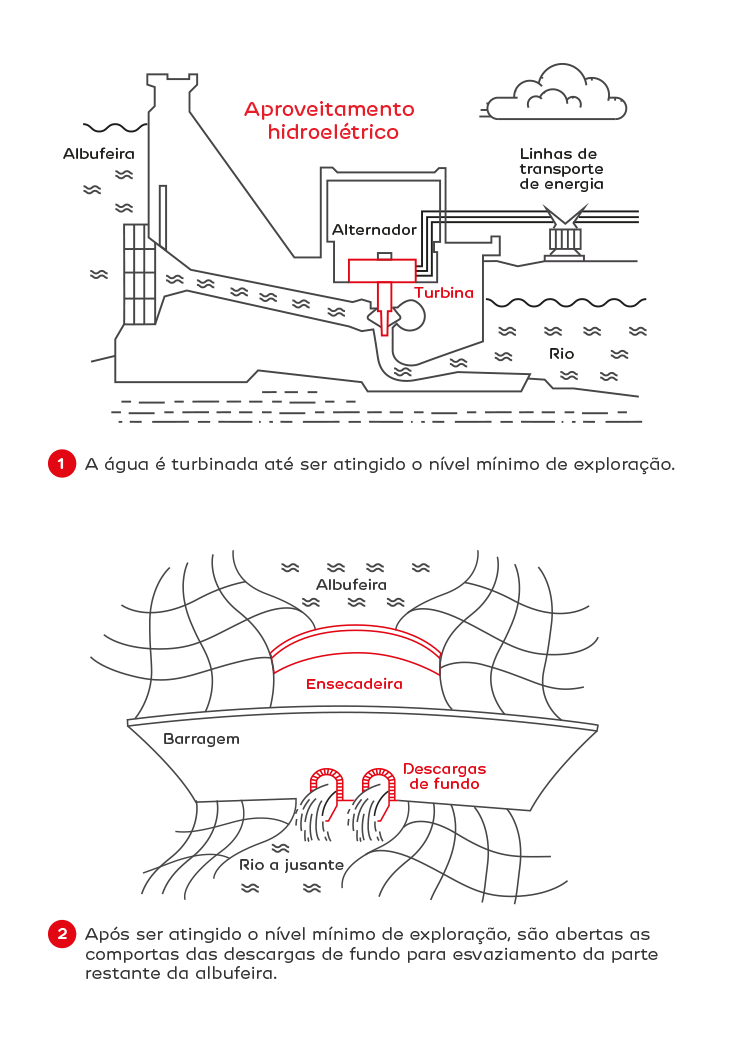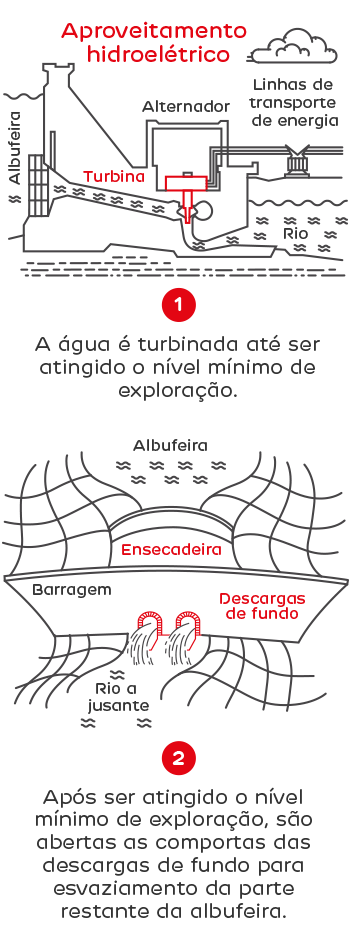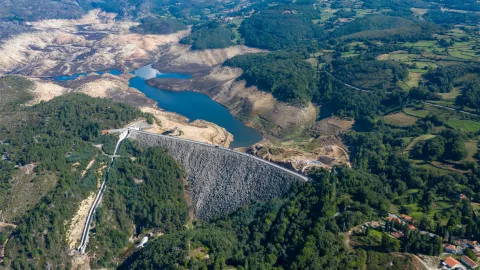Maintaining or repairing a dam is a complex task that requires the intervention of several specialized professionals. In addition to the work effort itself, there are risks — to people and the environment — that need to be acknowledged. Emptying the reservoir is rarely necessary to repair a dam, but how do we proceed when it has to be done?
The emptying of reservoirs usually only happens when the flow rates are lower, which is what happens in Portugal during the summer season. This is a concern for the area where the work is located because the reservoirs, aside from beautifying the landscape, allow the accomplishment of activities that bring economic value to the region where the dam is located. When they are emptied, these activities are temporarily compromised.
However, safety is paramount, and EDP Produção, an EDP Group company that manages energy production in Portugal, must always be on the lookout for the 59 hydroelectric plants it operates. As such, there will be times when repairs must be made. In this case, the necessary measures shall be taken to carry out the repairs as quickly as possible to minimize the inconvenience associated with it.
“Take the plug off” the reservoir
After a soaking bath, we can empty the tub in our house with a simple gesture: we remove the drain plug, and the water quickly disappears. In the case of a reservoir, we may think similarly, but the outflow of water has to occur gradually and be very well controlled.
The water exits the reservoir through the bottom discharge of the dam and travels downstream. Sounds easy? Maybe, but if water doesn't pass through the plant's turbines, then it doesn't produce power. According to the experience of Ilídio Ferreira, head of Structural Safety at EDP Produção, “When you lower the level, you try to get as much of the flow rate as possible through the turbines in order to produce energy. The emptying is done by the bottom discharge only when the levels are too low, and it cannot pass through the turbines.”
Passing through the turbines or not, the water eventually flows to the downstream riverbed and finally to the sea.
Then, for it to reach the work site and to work safely, it is necessary to have the bottom of the valley dry, and this is the function of the cofferdam. It is a concrete structure integrated into the temporary river bypass when the dam is built, which temporarily allows the riverbed to dry out, facilitating the rehabilitation work.


Although relatively simple, this drainage technique is effective and has not changed over the years, but close attention must be paid to dam stability. The speed of emptying can endanger the safety of the structure, so the process must be accompanied by a monitoring plan not only during the lowering of the reservoir water level but also during refilling.
Emptying… to some extent
Ilídio Ferreira is not new to any of this, as he was able to see some "emptyings" throughout his career. After all, he joined the company in 1980. In his words, emptying a dam's reservoir is usually done for “structural or hydraulic-operational safety issues, or to allow access to habitually submerged areas for inspection and/or repairs.”
These are the reasons that lead to the need for emptying the dam. Of course, there are more advanced techniques to access the dam infrastructure nowadays that does not force us to empty the reservoir completely. Such is the case, for example, with the use of divers, which allow for reaching deep depths in underwater repairs. However, the method is chosen in each intervention depending on the characteristics and dimensions of the work.
Ilídio Ferreira explains that the emptying of a reservoir happens “according to a plan that lowers the minimum level of exploitation.” This plan determines the extent to which EDP can draw water from the reservoir, which is stipulated in the concession contract. If it is necessary to remove water in such a way that this minimum level is exceeded - something that happens in cases of emptying - the company can only proceed when authorized by the Portuguese Environment Agency (APA) and the Institute of Nature Conservation and Forests (ICNF).
Waterproofing a dam
There is nothing better than using a concrete example to understand the process of emptying the reservoir and repairing a dam.
In the summer of 2019, it was necessary to empty the reservoir of the Paradela dam, located in the Peneda-Gerês National Park, in the municipality of Montalegre, due to increased water infiltration in the structure over time. After obtaining the necessary authorizations for this purpose, EDP had to carry out a set of works worth about 4 million euros to seal the upstream dam with a PVC membrane. Due to the size of the repair and its depth (110 meters), it was not possible to use other techniques, such as divers.
In order to minimize losses in electricity production, the reservoir was emptied both using the turbines and the bottom discharge.
Since 1980, there had been no emptyings of this dam, which went into service in 1958. The membrane applied in 1980 was a solution that was not sufficiently capable of absorbing the stress of the water pressure. Still, the system used was effective for about 10 years - at that time, it was the best technology available on the market.
Armando Camelo, the project coordinator for the reduction of infiltration rates in the Paradela dam from the Dams Engineering Directorate (DEB) of EDP Produção, explains that a new PVC membrane was applied to prevent pleating in the submerged areas and excessive deformation. This same system had already been used in other EDP works. It was used for the first time 28 years ago at the Pracana Dam, where the PVC membrane is expected to be effective for another 20 years.
What about ecosystems?
When maintaining a home aquarium or simply removing water to clean it, we must be very careful about the fish that live there. We need to ensure that the aquarium remains a good home for its inhabitants. The same is true, on a much larger scale, when emptying a reservoir.
To minimize the environmental impacts of the drainage, the entire process must be prepared for and accompanied by continuous monitoring of the physiochemical parameters of the water quality in the reservoir and downstream river. Regarding the fish community, it is necessary to characterize them in advance, followed by an awareness of their behavior and environmental conditions.
During the process, we analyze the behavior of existing fish and the physiochemical conditions of the water. “Decisions are made based on what is detected in the follow-up,” describes Teresa Cavaco, senior technician of the Sustainability Department (STD) of EDP Produção. For example, responsible teams may even have to resort to capturing some specimens of indigenous species that may be trapped in puddles. These are then transported in aerated tanks to specific locations of the rivers and streams affluent to the reservoir, ensuring its future recolonization.

Should physical and chemical conditions deteriorate, it is also necessary to capture and transport fish of native species to other locations. In this context, electric fishing or fishing nets with specific characteristics can be used, both methods always being applied by specialists working with EDP.
In the Paradela dam, Teresa Cavaco explains that the work was carried out without any noteworthy impacts as the best environmental practices were adopted at the time, namely in the management of the screen residues produced and in the correct conditioning of the sediments removed during the work in the previously approved location. On the other hand, it was not necessary to remove the fish and move them to other locations, as the reservoir was not completely empty, and the volume of water retained, and the adequate maintenance of its quality allowed for the survival of the fish fauna. The careful management of the remaining water volume contributed greatly to this result.
"If we started seeing that there was a large accumulation of fish, or that they were trapped in isolated areas during the emptying period, we would have to remove them and transfer them to other streams. In this case, it was not necessary, but these sites were all identified before the work began.", explain Teresa Cavaco from EDP Produção.
We need to monitor the water quality
To ensure the survival of the fish, the reservoir and downstream river must have good quality water. Water quality monitoring must always be ensured and is ensured by continuous monitoring during emptying, work, refilling, and post-work periods.
As the person responsible for the environmental monitoring of the Paradela dam rehabilitation work, Teresa Cavaco explains the procedures: “Buoys with multi-parametric probes were installed in the reservoir and downstream to accurately measure various parameters such as temperature, dissolved oxygen, pH, or turbidity. This information is always available in real-time via GPRS."
Water quality monitoring was carried out by EDP Labelec and fish fauna monitoring by the Fluvial Ecology Laboratory (LEF) Team at the University of Trás-os-Montes (UTAD).
In addition to this control, other preventive measures are required during the work, such as paying attention to where the PVC screens and work materials are stored. Teams must also be very vigilant in controlling product spills, as the water trapped in the reservoir cannot be at risk of contamination.
To plug the reservoir
When refilling a bath, just plug the drain, open the tap and let the water run to the desired level. Things change when we start analyzing how to refill a reservoir. Refilling starts from the moment the bottom discharge gate is closed — the water starts to be stored in the reservoir. This depends on the flow rate. Sometimes, we also ask St. Peter for a little help...
“We cannot define the time a refill takes, and the reason is rain. With rain, there are more affluent flows and it does not take so long. If there is little rain, it can take many months.” explain Ilídio Ferreira from EDP Produção.
The refilling of the Paradela dam reservoir began on October 24, 2019. In the monitoring phase, two observations were made per week to monitor the dam behavior. Over the years, it will be necessary to check the effectiveness of the waterproofing frequently. It is expected that it will last 20 years or more.
For the protection of the fish, EDP is monitoring the evolution of the fish communities and assessing the need to restock, but it will hopefully not be necessary because, in Teresa Cavaco's words, “We had a very low mortality rate of the fish. According to the results obtained, the need to carry out fish restocking will be assessed, but is not expected at this stage.”
At the Rhythm of Nature
Emptying a dam's reservoir is a complex and time-consuming process, but sometimes it is necessary. EDP understands the importance of maintaining its production plants for the benefit of the population and the environment. Also, the various stages of emptying provide visitors with a “visual spectacle” that slowly follows the passage of time. So much so that its magnificent views justify several walks on the site.
So if you ever go to Gerês and pass through the Paradela dam, you will probably see this 110-meter high structure. Take the opportunity to visit a small beach in the reservoir, which is submerged when the water level rises, or to photograph the landscape, which will always be “dressed up” and ready to receive you.











